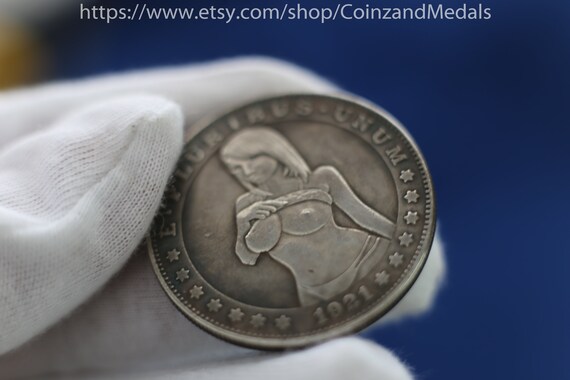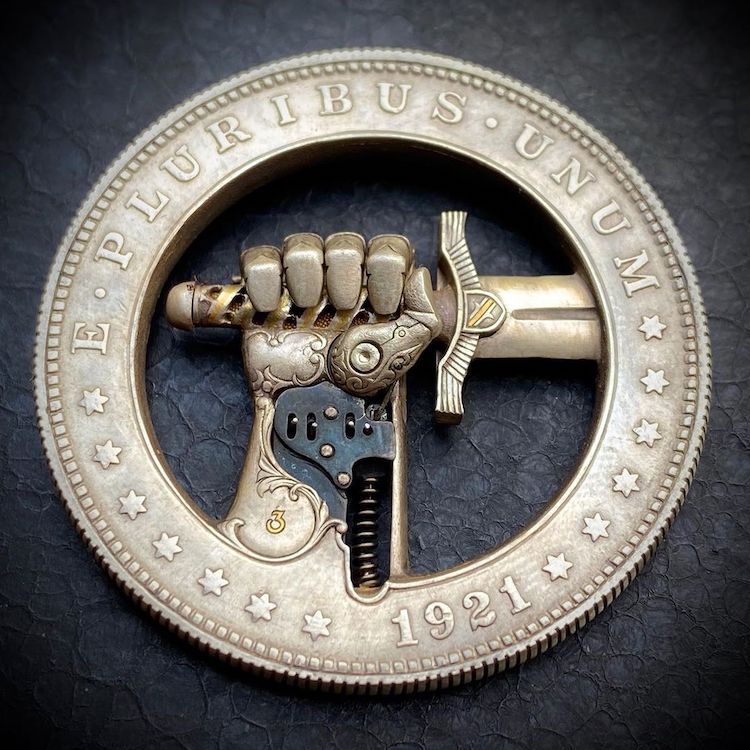Hobo Nickel
The Hobo Nickel Series debuted in 2016 from HotCo and the Osborne Mint (Osborne Precious Metals). The 2016 Hobo Nickels included a total of five different designs. The silver rounds in this first series were closely derived from the original Buffalo Nickel designs by James Earle Fraser in circulation from 1913 to 1938. The Buffalo nickel debuted in 1913, but it wasn’t until the Great Depression struck that hobo nickel carving reached its peak. During this period, buffalo nickels were the most common nickels in circulation. The sudden scarcity of jobs in the early 1930s forced a huge number of men to hit the road. What's a Hobo Nickel? The term hobo nickel is used generically for any engraved or carved. Hobo nickel Monkey carved on a 1972 Kennedy Half Dollar coin Artisticallytwistd. From shop Artisticallytwistd. 5 out of 5 stars (18) 18 reviews $ 75.00 FREE shipping Favorite Add to 1928 Skull Pattern Buffalo Nickel ATXEngraving. From shop ATXEngraving $ 80.00. Favorite Add to. Dating back as early as the 18th Century, America’s hobo subculture passed time by carving miniature designs into circulating coinage. Although the term Hobo Nickel is generic and can be used to identify many various denominations, more carvings were made from the American five cent piece than any other coins.
100 years ago Indian head (buffalo) nickels were altered by Hobos scratching in a beard or hat, and traded for something worth more than a nickel.
My Hobo Nickel Rings are made from the same nickels minted from 1913 to 1938. Not recast versions, of the same engraved coin, but one-of-a-kind custom made for the individual. I use traditional hand-engraving techniques that include power assisted tools. I fabricate the bands from heavy 14-gauge Sterling Silver sheets for a complete band of your size, with the engraved coin soldered on top. This may be excessive, but makes for a more substantial and comfortable feel than other types.
History : The hobo nickel is a sculptural art form involving the creative modification of small-denomination coins, essentially resulting in miniature bas reliefs. The US nickel coin was favored because of its size, thickness, and relative softness. However, the term hobo nickel is generic, as carvings have been made from many different denominations.
The hobo nickel is a sculptural art form involving the creative modification of small-denomination coins, essentially resulting in miniature bas reliefs. The US nickel coin was favored because of its size, thickness, and relative softness. However, the term hobo nickel is generic, as carvings have been made from many different denominations.
The hobo nickel is a sculptural art form involving the creative modification of small-denomination coins, essentially resulting in miniature bas reliefs. The US nickel coin was favored because of its size, thickness, and relative softness. However, the term hobo nickel is generic, as carvings have been made from many different denominations.

Due to its low cost and portability, this medium was particularly popular among hobos, hence the name.
Early altered coins (1750s–1913)
The altering of coins dates to the 18th century or earlier. Beginning in the 1850s, the most common form of coin alteration was the “potty coin”, engraved on United States Seated Liberty coinage (half dime through trade dollar) and modifying Liberty into a figure sitting on a chamber pot. This time period was also the heyday of the love token, which was made by machine-smoothing a coin (usually silver) on one or both sides, then engraving it with initials, monograms, names, scenes, etc., often with an ornate border. Hundreds of thousands of coins were altered in this manner. They were often mounted on pins or incorporated into bracelets and necklaces. The love token fad faded out in the early 20th century; love tokens engraved on buffalo nickels are rare. During this time period, hobo-style coin alteration could be found outside the United States, primarily in Britain, France, and South Africa.
Buffalo nickels

When the Indian Head, or Buffalo nickel, was introduced in 1913, it became popular among coin engravers. The big Native American head was a radical departure from previous designs and would not be seen on any subsequent coins. The large, thick profile gave the artists a larger template to work on and allowed for finer detail.

On earlier coins, the head was much smaller in relation to the size of the coin. For example, on a Lincoln cent, the head covers about one-sixth of the area. On the Buffalo nickel, the Native American’s head occupies about five-sixths of the area. Moreover, the nickel is a larger coin. Large heads also adorn the Morgan dollar and the Columbian half dollar commemoratives of 1892-93, but these coins were rarely altered due to their high value.
Another factor contributing to the Buffalo nickel’s popularity was the sex of the subject. Nearly all previous coins had depicted women (Liberty head nickels, Indian head cents, Barber and Morgan silver dollars). A male head has larger, coarser features (nose, chin, brow) that can be altered in many ways. Even the buffalo on the reverse could be changed into another animal or a man with a backpack.
Classic old hobo nickels (1913–1940)
Many talented coin engravers, as well as newcomers, started creating hobo nickels in 1913, when the Buffalo nickel entered circulation. This accounts for the quality and variety of engraving styles found on carved 1913 nickels. More classic old hobo nickels were made from 1913-dated nickels than any other pre-1930s date.
Many artists made hobo nickels in the 1910s and 1920s, with new artists joining in as the years went by. The 1930s saw many talented artists adopting the medium. Bertram Wiegand, known almost exclusively as Bert, began carving nickels in the teens, and his student George Washington Hughes, known as Bo, began carving in the late teens (and up to 1980). During this period, Buffalo nickels were the most common nickels in circulation.
Later old hobo nickels (1940–1980)

The 1940s, 1950s, 1960s and 1970s were a transitional period for hobo coin engravers, during which the Buffalo nickel was gradually replaced by the Jefferson nickel. Some veteran nickel carvers such as Bo and Bert continued making hobo nickels in the classic old style. Bo, in fact, did his best work in the early 1950s, when he carved many spectacular cameo portrait hobo nickels.
During this 40-year period, many new carvers appeared, and style and subject matter became decidedly modern. Subjects became more ethnically and socially diverse (e.g., a Chinese woman with triangular hat, hippies with long hair and glasses, men wearing floppy hats, etc.). Some of these new artists used new techniques such as power engravers, vibrating tools, and felt marker pens to add color to hair.
By the end of the 1970s, most Buffalo nickels had disappeared from circulation, and the majority of engravings were performed on worn coins. Bo, for example, was forced to obtain Buffalo nickels from coin dealers, some of whom commissioned carvings.
Hobo Nickel Society
Modern hobo nickels (since 1980)
Many carvers who were active during the 1960s and 1970s continued carving Buffalo nickels into the 1980s. Their coins were altered using punches (dashes, dots, arcs, crescents, stars) and some carving of the profile. The area behind the head is usually rough from dressing with a power tool. They created standard design hobo nickels (derby and beard), as well as many modern subjects, such as occupational busts (fireman, railroad engineer, pizza chef), famous people (Uncle Sam, Einstein), hippies, and others.
Real Hobo Nickels
A major event occurred in the early 1980s, demarcating the transition from “old” to “modern” hobo nickels. This was the publication of a series of articles by numismatist Del Romines on the subject of hobo nickels. He soon published the first book on the subject, Hobo Nickels (ASIN B0006R7SFW), in 1982. Both centered on Bo and his carvings.
This resulted in some new artists entering the field, most of whom simply copied Bo’s nickel artwork from the illustrations in Romines’s book. The two major Bo-style copycats were John Dorusa and Frank Brazzell. Together, they produced 20,000 or more modern carved nickels, most of which were copies of Bo’s designs. Dorusa even copied Bo’s “GH” signature (for “George Hughes”) on many of this early creations. Pressure from prominent hobo nickel collectors such as Bill Fivaz convinced Dorusa to stop carving “GH” and put his own initials or name on his works. Dorusa and Brazzell also produced original works, featuring non-traditional subject matter (conquistadors, Dick Tracy, skulls, etc.). The large number of Bo copies led many collectors to label all modern carved nickels as “Neo-Bo’s”, a term no longer in use.
Hobo Nickel Mechanical
Other carvers such as “Cinco de Arturo” (Arturo DelFavero) also appeared in the 1980s and 1990s, introducing more modern subject matter (cartoon characters, witches, and animals). Most nickel carvers of the 1980s to mid-1990s are regarded by collectors as mediocre at best, but circa 1995, Ron Landis, an engraver in Arkansas, began creating superior quality carvings. For about four years, Landis was the only nickel carver creating superior carvings, at the rate of only one to two dozen per year (all signed, numbered, and dated). Many other professional engravers have since begun creating hobo nickels. Landis and “Cinco de Arturo” are two of four known living artist practicing this craft prior to the year 2000. The others are Sonny Carpenter, and Bill Jameson (Billzach), All four are considered superior carvers, and ground breakers that inspired the current renaissance.

Some current prolific carvers are converting from quantity to quality, making fewer pieces of high artistic quality (as the market is flooded with lower quality quickly-made carvings). Modern carvings of superior quality sell for about the same prices as classic old original carvings of equal quality by unknown artists.
From the early 1980s to the present, modern lesser-quality carvings could and still can be purchased for as little as $5 to $10 each. Many new collectors found it hard to obtain good-quality old original hobo nickels (as they are so scarce and costly), so they began collecting the readily obtainable and cheap modern works.
About 100,000 (and possibly as many as 200,000) classic hobo nickels were created from 1913 to 1980. Modern artists have created (and continue to create) altered nickels in such large quantities that, within the next few years, the number of modern carvings is expected to surpass that of classic old hobo nickels. Most of the 100,000-plus classic old hobo nickels are not yet in the hands of collectors, whereas almost all modern carvings are. Among numismatists, the modern carvings already greatly outnumber the classic old hobo nickels.